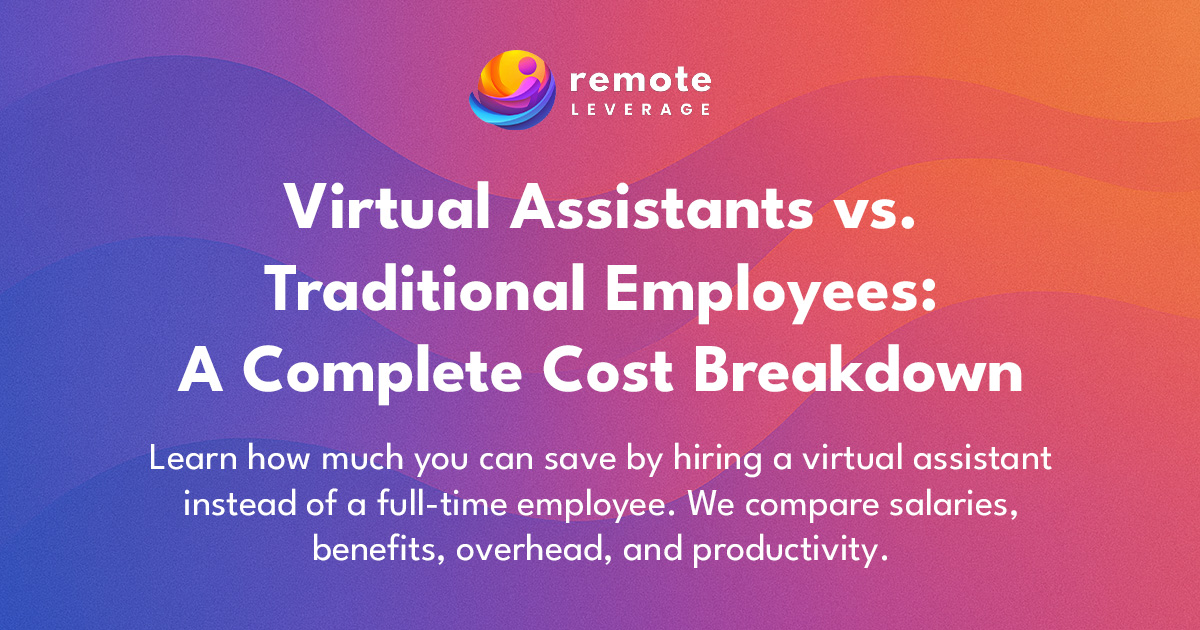
Hiring help is a big decision. For many small businesses, solo founders, and fast-growing startups, the choice often comes down to two options: hire a traditional employee or bring on a virtual assistant (VA).
While traditional employees offer in-house support, virtual assistants provide flexible, remote help at a lower cost. But how big is the difference?
In this guide, we break down the real costs of hiring a VA compared to a traditional employee, so you can make the best decision for your business.
Let’s start with the biggest expense: compensation.
Traditional Employee
According to the U.S. Bureau of Labor Statistics, the median annual salary for administrative assistants is $44,080, or roughly $3,673 per month
Source: BLS.gov
This does not include taxes, benefits, or overhead costs.
Virtual Assistant (via Remote Leverage)
Remote Leverage VAs typically cost between $600 and $1,500 per month, depending on the number of hours and complexity of tasks. Most businesses start with 20 hours per week, which provides consistent support without the full-time commitment.
Monthly Savings: $2,000 to $3,000+
Traditional employees require additional costs beyond their base salary.
Employer Payroll Costs (U.S.):
These add an average of 15 to 25 percent to the employee’s total compensation package.
Employee Benefits (Average Annual Costs):
Source: U.S. Chamber of Commerce
Virtual Assistant
Savings Estimate: $10,000 to $20,000 per year
Traditional Employee
Virtual Assistant
Savings Estimate: $2,000 to $5,000 per employee per year
Hiring and training new employees can be time-consuming and expensive.
According to SHRM, the average cost-per-hire is around $4,700
Source: SHRM
It can take 1 to 3 months before a new employee reaches full productivity.
Virtual Assistant (Remote Leverage)
Savings Estimate: Weeks of onboarding time and thousands in hidden costs
In-house staff are salaried regardless of productivity. According to Zippia, 89% of employees admit to wasting time daily.
Source: Zippia
Virtual Assistants
This flexibility is ideal for startups, solopreneurs, and service businesses that have changing workloads.
Full-time employees often work in-office with distractions and unproductive hours.
The Reality:
According to a survey by Salary.com, 89% of employees admit to wasting time at work every day
Virtual Assistants
Hiring a VA means you are paying for results, not just hours logged.
| Category | Traditional Employee (Monthly) | Remote Leverage VA (Monthly) | Savings |
|---|---|---|---|
| Base Salary | $3,673 | $800 (average) | $2,873 |
| Payroll Taxes & Benefits | $1,000+ | $0 | $1,000+ |
| Equipment & Office Space | $250+ | $0 | $250+ |
| Onboarding & Training | High | Minimal | Time + $4,000+ |
| Total Monthly Cost | $5,000+ | $800 to $1,500 | $3,500 to $4,500 |
Hiring a virtual assistant is not just a cost-saving move. It is a strategic decision that lets business owners scale with less risk, more flexibility, and higher productivity.
If you want to:
A virtual assistant from Remote Leverage can help you do it.
We match U.S.-based businesses with highly skilled, college-educated virtual assistants who are fluent in English and ready to support your business from day one.
✅ English-speaking virtual assistants
✅ Trained in the tools you already use
✅ Located in U.S.-friendly time zones
✅ Vetted, dependable, and affordable
Save money. Save time. Grow smarter.